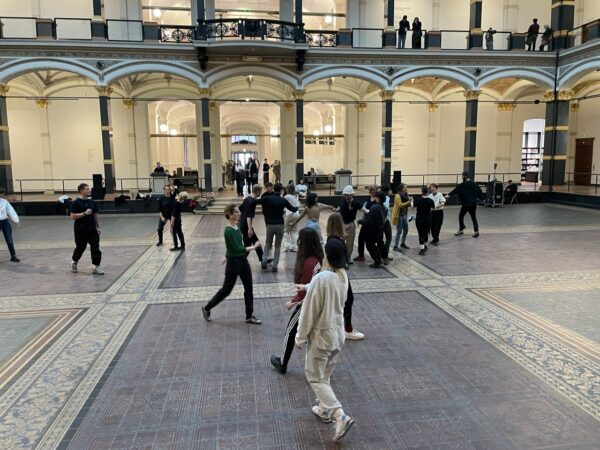In September 2022, I hosted a series of immersive physical practice sessions at Martin Gropius Bau. This event was a part of Breathe, a discourse programme that unfolded in echo to the exhibition YOYI! Care, Repair, Heal and explored how different power relations impact our ability to breathe. The programme was curated by Magnus Elias Rosengarten.
My idea was to organize multiple movement sessions, which could be experienced from the inside on the physical level by the participants, but also — from the outside by the spectators and passers-by. The sessions would take place in the beautiful Atrium space of Gropius Bau, which is the first place of entry to the exhibition. So I wanted to make sure that whoever happened to be there during those sessions could feel free to join with any sense they wish: kinaesthetically, visually, or auditory.
I invited the participants to explore the concepts of care, repair, and healing on the physical level. Every session lasted for about an hour and we had three of them overall, each offering a specific angle to explore the overarching concepts of the exhibition.
First, I briefly introduced the panarchy framework that can be used to facilitate adaptive resilience at the scale of a body, but also of a collective. I then introduced some exercises to develop a common movement language for the group in relation to the concepts of care, repair, and healing. For instance, some of the exercises involved exploring fluid resilience as a way to practice care in a physical way through movement; while others invited the participants to induce a brief uncomfortable feeling (or pain) in their partners, in order for them to be able to work on regeneration techniques and recovery breathing.

Panarchy schema that depicts 4 different states of adaptive variability that we use in our practice.
For the second half of the session, we had free improvisation where we explored these ideas and their reflection in movement and collective dynamics.
During the sessions, we used motion tracking fractal choreography AI, developed in the frame of EightOS practice, which uses video tracking and surveillance technology to provide live feedback on movement variability to the participants. This feedback can be used by the movers to see whether they tend to get stuck in a certain pattern of movement and to help them explore more possibilities and break their habitual patterns. As it’s the AI giving the feedback, the figure of a central choreographer is removed and is instead delegated to each participant.

The feedback is given visually but also through auditory feedback creating a soundscape for the session. Every sound reflects the current state but also proposes a certain physicality that could be introduced to shift to another type of variability.

As a result, this experience can be both experienced live and observed from the outside. In fact, the participants were also encouraged to step out and to observe, while the visitors of the museums were gently invited to step in and to participate if they wish to take part in this collective movement session.
Link to the event: Martin Gropius Bau


Photos by Anastasia Pilepchuk
